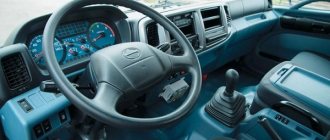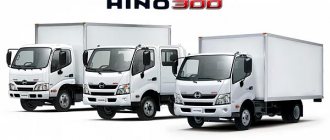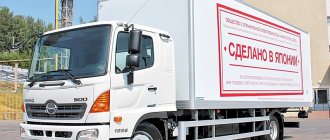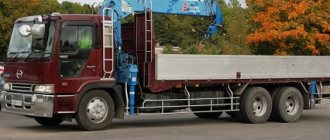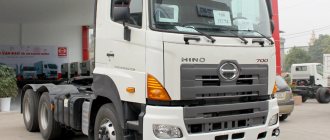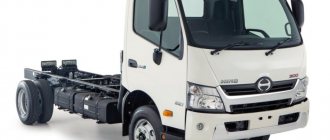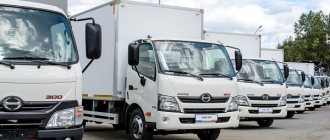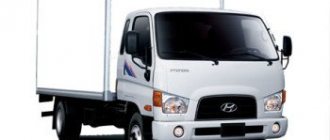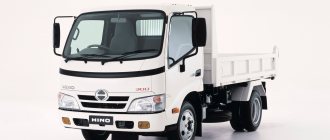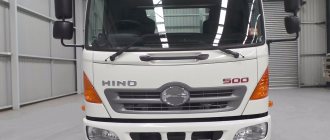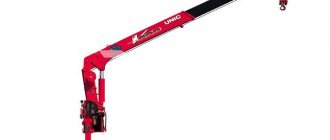A simple and unpretentious Japanese worker
HINO 500 trucks belong to the medium- and large-tonnage family of Japanese commercial vehicles (part of the Toyota corporation). The HINO 500 series is in a segment with very close competition from trucks made in Japan, Korea, China and Russia. There are also strong European “classmates” with whom you also need to compete in the struggle for the choice of carriers. However, the demand for HINO 500 is stable even in difficult economic conditions. What are the strengths of this model, besides the fact that these are 100% Japanese-made machines? The
Hino 500 family belongs to “young”, produced since 2013. However, this is far from a freshly baked, but a time-tested, repeatedly tested product (made on the basis of the Hino Ranger model, popular in Japan and Asian countries). HINO Ranger has been produced since 1969 year, so the manufacturer does not lack experience in a series of this tonnage.
Since 2013, the updated Hino Ranger has been supplied with Euro-4 engines, with an EGR system, without the AdBlue reagent, which is unreliable in cold weather. The design of trucks imported to Russia is adapted for cold climates, designed for regular overload, poor roads and low-quality diesel fuel. The service life of the HINO 500 is extended – 30 thousand kilometers.
All trucks are equipped with large, high-capacity fuel tanks of 200 or 300 liters, and a highly versatile frame that allows the installation of dozens of options for body superstructures. In order to ensure maximum load capacity, the manufacturer has simplified the design of the vehicle as much as possible, compared to the Hino Ranger (advanced lightweight metal alloys of increased strength are used).
In Russia, the Hino 500 family is represented by trucks with a gross weight of 12 tons (GD line), 17.5 tons (GH) and 26 tons (FM).
Modification GD / 12 tons (7 options)
- Chassis curb weight: 3.97 t; 3.98 t; 4.055 t; 4.155 t; 4.1 t; 4.185 t; 4.125 t.
- Chassis load capacity: 8.03 t; 8.02 t; 7.945 t; 7.845 t; 7.9 t; 7.815 t; 7.875 t.
- Wheelbase: 3.75 m; 4.25 m; 4.85 m; 5.15 m.
- Overall length: 6.78 m; 7.39 m; 8.24 m; 8.74 m.
- Rear overhang: 1.7 m; 1.81 m; 2.06 m; 2.26 m.
- Rear chassis height: 0.875 m or 0.84 m.
- Turning radius on wheels: 6.9 m; 7.7 m; 8.6 m; 9.1 m.
- Turning radius from wall to wall: 7.6 m; 8.4 m; 9.3 m; 9.8 m.
All seven options have the same values:
- total weight – 12 tons;
- load on the front axle – 3.9 t, on the rear axle – 8.1 t;
- width – 2.355 m and height – 2.495 m;
- ground clearance (differential) – 200 mm;
- track width: front – 1.76 m, rear – 1.69 m.
- tire size – 265/70R19.5.
Modification GH / 17.5 tons (6 versions)
- Chassis curb weight: 5.355 t; 5.29 t; 5.525 t; 5.355 t; 5.615 t; 5,505 t.
- Chassis load capacity: 12.145 t; 12.21 t; 11.975 t; 12.145 t; 11.885 t; 11,995 t.
- Wheelbase: 4.62 m; 5.51 m; 6.2 m.
- Overall length: 7.57 m; 9.46 m; 10.55 m.
- Rear overhang: 1.91 m; 2.55 m; 2.95 m.
- Rear chassis height: 1.06 m or 1.02 m.
- Turning radius on wheels: 7.8 m; 9.8 m; 10.9 m.
- Turning radius from wall to wall: 8.5 m; 10.5 m; 11.6 m.
All seven options have the same values:
- total weight - 17.5 tons;
- load on the front axle – 6.5 t, on the rear axle – 11 t;
- width – 2.47 m and height – 2.685 m;
- ground clearance (differential) – 245 mm;
- track width: front – 1.925 m, rear – 1.84 m.
- tire size – 295/80R22.5.
Modification FM / 26 tons (three-axle dump truck)
- Curb weight: 11.475 t.
- Gross weight: 26 t.
- Load on the front axle: 6 tons, on the rear axle – 20 tons.
- Chassis load capacity: 14.525 t (the design allows for a load weight of up to 20 t).
- Wheel formula: 6x4.
- Wheelbase: 3.9 m + 1.3 m.
- Overall length: 7.38 m. Width: 2.55 m. Height: 3.29 m.
- Rear overhang: 1,915 m.
- Chassis height rear: 1.075 m, front: 1.03 m.
- Turning radius on wheels: 8.5 m.
- Turning radius from wall to wall: 9.1 m.
- Differential ground clearance: 245 mm.
- Tire size: 295/80R22.5.
The body on HINO 500 FM dump trucks is a steel welded structure, with automatic opening of the tailgate, heated by exhaust gases. Its volume is 16 cubic meters. Unloading angle: 50%. Rise speed – 30 seconds. The body length is 5 m and the width is 2.272 m.
In the basic configuration, any of the Hino 500 variants has a rich list of equipment. Among the safety systems available in the database, one cannot fail to mention the pneumatic braking system, ABS, protection of passengers and the driver in a frontal collision.
Also in the standard version, the HINO 500 is equipped with 2-component mirrors, an automatic cab tilting system, fog lights, a lifting front panel, a standard branded audio system, an air suspension for the driver’s seat and a full-fledged berth. By the way, in Japan, as in many Asian countries, manufacturers sell these trucks with a regular driver’s seat - without air suspension.
Sales of HINO cranes
We cooperate with individuals and legal entities. We offer special conditions for corporate clients (special prices, individual managers, customization of packages to suit the customer’s needs).
When purchasing a Hino loader crane from us, you can use various tools:
- Get a loan for HINO equipment.
- Leasing HINO equipment.
- Use the Trade-in program.
Our online configurator will help you select the appropriate equipment and submit a preliminary application.
In our company you can order a CMU on the Hino chassis of the following models:
Loader cranes on HINO 300 Series chassis:
- Model 300XZU-600. Total weight 3.5t. Category "B"
- Model 300XZU-640. Total weight 3.5t. Category "B"
- Model 300XZU-650. Total weight 3.5t. Category "B"
- Model 300XZU-710. Gross weight 8t. Category "C"
- Model 300XZU-720. Gross weight 8t. Category "C"
- Model 300XZU-730. Gross weight 8t. Category "C"
- Model 300XZU-720Crew Cab. Gross weight 8t. Category "C". Double row cabin.
Loader cranes on HINO 500 Series chassis
- Model 500MUA/MUG. Gross weight 12t
- Model 500LUA/LUG. Gross weight 12t
- Model 500J7A/P7A. Gross weight 18.0t
- Model 500S7G. Gross weight 18.0t
- Model 500P7G/S7A. Gross weight 18.0t
We also sell used Hino cars accepted via Trade-in from banks or leasing companies. The equipment undergoes thorough diagnostics and pre-sale preparation.
Engine
All modifications of the Hino 500 series cars use the same engine option. This is a six-cylinder in-line diesel engine model HINO J08E-UR with a displacement of 7684 cm3. It meets the Euro-4 standard, is equipped with an electronic common rail injection system, turbocharging with intercooling, exhaust gas recirculation system and an intercooler. The engine produces a maximum power of 260 hp. (191 kW) at 2500 rpm and maximum torque of 794 N.m at 1500 rpm. At the same time, the main advantage of this power unit is low fuel consumption, combined with high performance and torque.
Indeed, this engine is one of the models of efficiency in its class. In a city rhythm, it consumes 21-23 liters of diesel fuel per 100 km, on a suburban highway - 16-17 liters per 100 km.
This diesel engine is equipped with a turbine with technology for changing the geometry of the exhaust part. This ensures boost over the widest rpm range. The power units of the HINO 500 family are distinguished by an increased service life, which is supported by the presence of an additional heated separator and heated main fuel filter.
Price
The Hino Ranger truck in new technical condition is currently not available in the markets. This is due to the fact that its mass production was completely discontinued with the advent of the more modern Hino 500 model.
But you can find used options on the secondary market. Thus, models produced between 2000 and 2002 have an average cost of one million to 1.6 million rubles. Earlier versions, from 1992 to 1995, cost from 650 thousand to 750 thousand rubles. The price of a model takes into account factors such as year of manufacture, technical condition, mileage, and equipment.
Transmission
There are several transmission options. The main one is mechanical six-speed gearboxes of our own production, models HINO LJ06 and HINO MF06. 2-6 gears are synchronized. The gear ratios of this gearbox are as follows: 1st speed: 6.477; 2nd: 4.016; 3rd: 2,450; 4th: 1.470; 5th: 1,000; 6th: 0.723; reverse gear: 6.064. The final drive ratio is 4.100.
As an additional option, a nine-speed Eaton gearbox is available on the Hino 500. It is equipped with a so-called “slider” with a large gear ratio, and this makes it easier to start moving while loading. HINO 500 FM modification dump trucks are equipped with a nine-speed 9S1110 transmission from ZF, with synchronized 2-9 gears. Gear ratios: 1st speed: 12.278; 2nd: 8.829; 3rd: 6.281; 4th: 4.644; 5th: 3.478; 6th: 2.538; 7th: 1.806; 8th: 1.335; 9th: 1,000; reverse gear: 12,040. The final drive ratio is 5.428.
The clutch on all modifications of the truck is of the same type: dry, single-disc, diaphragm type, with pneumatic drive and pneumatic booster.
Technical characteristics of CMU based on HINO
Various types of CMU can be installed on the Hino chassis:
Lungs
— with a load moment of less than 4 tm.
Average
- up to 30 tm.
Heavy
— the load moment of such loader cranes is up to 36 tm.
Hino vehicles of several series are used as chassis for cranes:
HINO 300. The line includes cars with a gross weight of up to 3.5 tons, for which you only need to have a category B driver's license, as well as trucks with a gross weight of up to 8 tons.
HINO 500. The line includes vehicles with a gross weight of up to 26 tons.
HINO 700 (FS). An excellent option for installing heavy CMUs. The total weight of the vehicle is up to 30.7 tons.
Suspension and chassis design; brakes
The chassis frame of the Hino 500 trucks is riveted and reinforced. Its spars have different sections, with a profile height of 230 mm. All variants of this family are equipped with durable springs with shock absorbers installed on both axles. At the front and rear of the HINO 500 are four sheets of 80mm thickness. This type of construction provides optimal rigidity and strength with low weight.
In the first years of sale, only a non-adjustable rear air suspension was available for the Hino 500; later, an adjustable one was also available. At the front, a dependent suspension is used on longitudinal semi-elliptic springs, with hydraulic telescopic shock absorbers. There is also a stabilizer bar.
The leaf spring suspension comes with a HINO six-speed MF06 gearbox, and the air suspension comes with a nine-speed Eaton ES-11109 gearbox. The steered front wheels turn at a very large angle, which gives the 500 Series trucks enviable maneuverability compared to many competitors. The special design of the front axle axle and beam allows the wheels to turn almost perpendicular to the frame, significantly reducing the turning circle.
The rear and front brakes of the truck are drum type, the parking brake is equipped with spring energy accumulators. The design also includes a mountain brake.
Story
On the Russian market, this truck is not as popular as its European counterparts. Moreover, few people know the Hino Ranger, since this model is aimed primarily at the domestic Japanese market. Due to this, only right-hand drive versions are available.
Over the entire period of serial production, four generations were presented:
First generation
In 1969, the company introduced the first Ranger truck. Production of this model lasted until 1980. Several modifications were available to consumers with different wheelbase lengths (short, medium and long). Only diesel variations were offered as a power plant. The first generation was mainly aimed at the Japanese market, but there were also small quantities for export.
Second generation
This generation was introduced in 1980 and was the result of a deep facelift. The model was mass-produced until 1989, but production of the second generation continued at factories in Indonesia until 2003. The new model was also produced mainly for the domestic Japanese market, but small quantities were supplied to the markets of Europe and Russia. In appearance, the Hino Ranger cabin is quite similar to domestic KamAZ trucks. Namely, it is also equipped with a large bumper and four headlights. In technical terms, the second generation turned out to be much better than the first, but the equipment is not entirely suitable for use in Russian realities.
Third generation
Serial production of new cars started in 1989. Several modified versions were offered for Japanese market consumers, including the Space Ranger, Cruising Ranger and Rising Ranger. The manufacturer also began supplying equipment to the American market. Here the models received names that contained both letters and numbers. The model index here indicated the weight of the truck and the engine power (for example, FF3020). The third generation has also become available to consumers on the Russian market. As for the appearance, compared to its predecessor, the new generation has smoother lines. Enlarged headlights were installed, combined into a single unit. The cabin has become more comfortable. This was facilitated by higher quality interior materials and a new comfortable driver's seat, which has several adjustment options. In addition, the list of modified versions offered to consumers has also been expanded.
Fourth generation
The debut of the latest fourth generation took place in 2001. The new truck has a total weight of 12,000 kilograms. Its mass production is carried out by Hino Motors today. Export versions are produced under the designation Hino 500. The new line contains a large number of modified versions with different cabins, gross weight and wheelbase length. It is worth noting that the cabins can be equipped with a sleeping bag and have different widths and heights.
A variety of add-ons can be installed on the chassis of this truck. Currently in greatest demand are:
- Isothermal vans;
- Onboard cargo platforms;
- Car tanks, found on sewer trucks and fuel trucks;
- Refrigerators;
- Tow trucks;
- Loader cranes.
In terms of appearance, fourth-generation cars retained the style of previous generations. The exceptions were the headlights, which had an unusual shape and a bumper painted in the color of the cabin.
Cabin Hino 500
On all modifications, the cabin is installed the same: with a low roof, three seats and a compact but full-fledged sleeping place behind them. The design of the head of the HINO 500 is made in a typical oriental style. The appearance is dominated by decorative lines emanating upward from the bumper; Unusual are the direction indicators, separated from the headlights. When moving, the windshield wiper blades diverge in opposite directions.
The cabin interior clearly illustrates the love of Japanese engineers for compactness and practicality in everything. The cabin seats 3 passengers and is quite spacious inside. Everything here is made of high quality materials. There is a compact sleeping area behind the seats. It can hardly be used for long trips, but for a short vacation it is quite suitable. There is no unnecessary or superfluous information on the dashboard. Its design of the Hino 500 resembles a passenger car. The cabin clearly demonstrates the Japanese specialists' love for compactness. At the same time, the inside is quite convenient and comfortable, especially for the driver.
The driver’s workplace is organized according to the principle of dominance of reasonable sufficiency – the proprietary concept of “Roundish & donut cabin”, which can be translated as “rounded and flat space”. The basic color of the cabin is white. A comfortable individual driving position (both the seat and the steering column are adjustable) allows the driver to feel like he is in charge of the situation. In addition to several settings options, the driver's seat is also equipped with a retractable armrest and a standard pneumatic shock absorption system.
The interior finishing materials are clearly inexpensive and discreet. However, all the plastic and upholstery of the seats look very decent, and the panels fit together almost perfectly. The visibility from the cabin is excellent in all directions. Spherical mirrors located on the right practically eliminate the presence of dead zones.
Scope of application
Hino manipulators are optimally suited for moving in space, loading, unloading and transporting relatively oversized cargo, the weight of which is no more than 5 tons. At the same time, an important feature of the special equipment in question is the ability to perform work with loads located behind obstacles or below ground level, in particular when constructing wells or trenches.
The most important advantages of Hino manipulators are their simplicity of design and excellent reliability, strength and durability. The hook is equipped with a cable suspension, which makes it much easier to manipulate the load, including the ability to control its position during movement. Manipulators, including the Hino 700 series, are also equipped with a smooth lifting and lowering function, which allows you to work even with fragile and fragile objects without compromising their integrity.
Thanks to the listed characteristics and features, the Hino series handling equipment is an excellent option for use in the construction industry, warehouse, forestry or public utilities. Manipulators are capable of successfully moving a wide variety of types of cargo.
- Various materials, including construction;
- Containers and containers of various sizes;
- Garage buildings and cabins;
- Relatively compact special equipment;
- Many other types of cargo.
In addition to cargo transportation and construction work, Hino CMUs are widely used in the elimination of rubble and other consequences of emergency situations.
Reviews from Russian owners and drivers about the Hino 500
All owners and drivers of trucks of this model note that they are designed absolutely without any complications, in a simple way, but in a Japanese way, scrupulously and reliably. This manifests itself in many details. Ease of use lies in the details. For example, the aluminum running boards are molded to provide maximum clearance for dirt to clear off your shoes. The handrails are designed at an acceptable height, due to which entry and exit does not cause problems.
The steering column is adjustable in two directions, which increases the adaptability of the workplace, everyone praises it, although of course the decoration and equipment of the cabin are called Spartan.
No one has any complaints about the performance and reliability of both the engine and gearbox, as well as the engine brake and main drum brakes. On the highway, according to user reviews, a loaded car can reach a maximum speed of up to 100 km/h.
The reliable engine works without strain, thanks to the successful selection of power and torque. This engine is not at all demanding on the quality of fuel and will even digest dubious diesel fuel purchased in remote regions without consequences.
There are no problems with the injection pump and fuel injectors. This car is easy to maintain. A minimum of electronics and a simple design allow you to perform most of the maintenance yourself and save on visits to certified service stations. Drum brake linings “go” for at least 100 thousand km, and even more if out-of-town flights predominate.
The performance of ABS systems and especially ASR received kind words from drivers and owners. The standard stove is quite efficient, but many residents of the northern and Siberian regions still prefer to install an additional liquid heater or air heater.
Many also say that it would not be superfluous to add rear parking sensors to the standard equipment of the car. However, parking sensors are included in the list of additional options, and you can install it yourself. The downside is that there are problems with spare parts. In Russia we have relatively few suppliers of parts for this car. And if in the Far Eastern regions of the country there are no problems with purchasing spare parts, then in the central and western regions it can be difficult to get them.
In general, Russian owners speak of the HINO 500 as a truck that is designed to work without downtime, as an unpretentious workhorse. If handled correctly, the Hino 500 will regularly generate profits and not be bothered by breakdowns. And this is the most important thing for anyone involved in the transport business.
Maintenance and repair of equipment on the HINO chassis
You can order maintenance and repair services for the chassis of Hino cranes at one of our branded service centers: in Dolgoprudny, Mytishchi and at 32 km of the Moscow Ring Road (AGM TRACT). We provide a full range of services: from warranty technical maintenance of equipment to complex repairs of the engine, chassis, frame or electrical equipment.
Our specialized service stations are:
1800 m2 service area
. Due to this, within one service station we were able to place posts for various types of work. Everything is done in one workshop, without the need to deliver the car and its components anywhere.
19 posts for maintenance and repair
. Each of the posts is 100% equipped with everything necessary (from keys to dealer diagnostic scanners). Due to this, the posts are independent of each other, which allows us to service up to 30 cars per day at one service station.
Spare parts warehouse with an area of 450 m2
. Our warehouse with an area of 450 m2 has a large stock of parts and components for different series of Hino chassis. The stock assortment is replenished daily. When you contact us, you will not have to wait a long time for the delivery of the necessary spare parts.
23 certified specialists
.
Our employees are trained at HINO educational centers and have expert knowledge of the features of cars of this brand. We guarantee high-quality maintenance and repairs according to the original specifications of the car src=»https://www.dm-hino.ru/images/service/relax-zone.png» class=»aligncenter» width=»400″ height=»400″[ /img] Comfortable client areas
. We care about your comfort. Our client areas have comfortable sofas and monitors on which you can monitor the progress of repair work via video link. It is possible to order coffee or lunch.
Official guarantee
. We provide a dealer warranty. The official warranty period for all chassis series is 4 years, mileage is 250,000 km for the 300 series, 300,000 km for the 500 series. For 700 series cars - up to 2 years without mileage restrictions
Price HINO 500
New Hino 500 trucks are offered in Russia at prices starting from 5,500,000 rubles. The warranty on new HINO 500 trucks is 24 months or 100 thousand km, whichever comes first. For used cars of this model they ask from 2.5 to 4.5 million rubles.
Currently, Russian carriers put about four dozen bodies on the HINO 500. The most popular of them are an isothermal and manufactured goods van, an onboard platform and a platform with crane-manipulator installations. It’s less common to see curtain-sided “sides,” and even a little less common are tow trucks, garbage trucks, dump trucks, and concrete mixer trucks.
Reviews note that, thanks to the large steering angle of the front wheels, power steering and decent visibility, it is very easy to drive the car. Perhaps the greatest number of kind words in positive reviews is about the excellent maneuverability of these trucks.
Purpose
The Hino Ranger truck is highly versatile. However, it is most popular in the commercial segment, where it carries out:
Transportation of any cargo, regardless of their weight and dimensions; Various works in the fields of industry and construction; Transportation of any products and other similar goods transported under special temperature conditions.
This truck is often used by owners of large retail chains and various areas of the commercial segment. In addition, the model is very popular in private use. This is because the Hino Ranger has excellent performance and low cost, which makes it more cost-effective than its European counterparts.
